Torrens University PUBH6002 Global Health Assignment Solution
VerifiedAdded on 2022/11/13
|5
|1250
|380
Homework Assignment
AI Summary
This assignment solution addresses two key questions related to global and environmental health. The first question explains how climate change influences the rate of vector-borne diseases by affecting the vectors' life cycles and distribution, as well as impacting greenhouse effects and human activities that contribute to these changes. The second question explores the profound effect of foreign policy on public health, detailing three ways foreign policy influences public health issues: aid, trade, and national security. The solution provides examples of how these factors impact global health, including responses to disease outbreaks and bioterrorism, and references relevant literature to support the arguments.
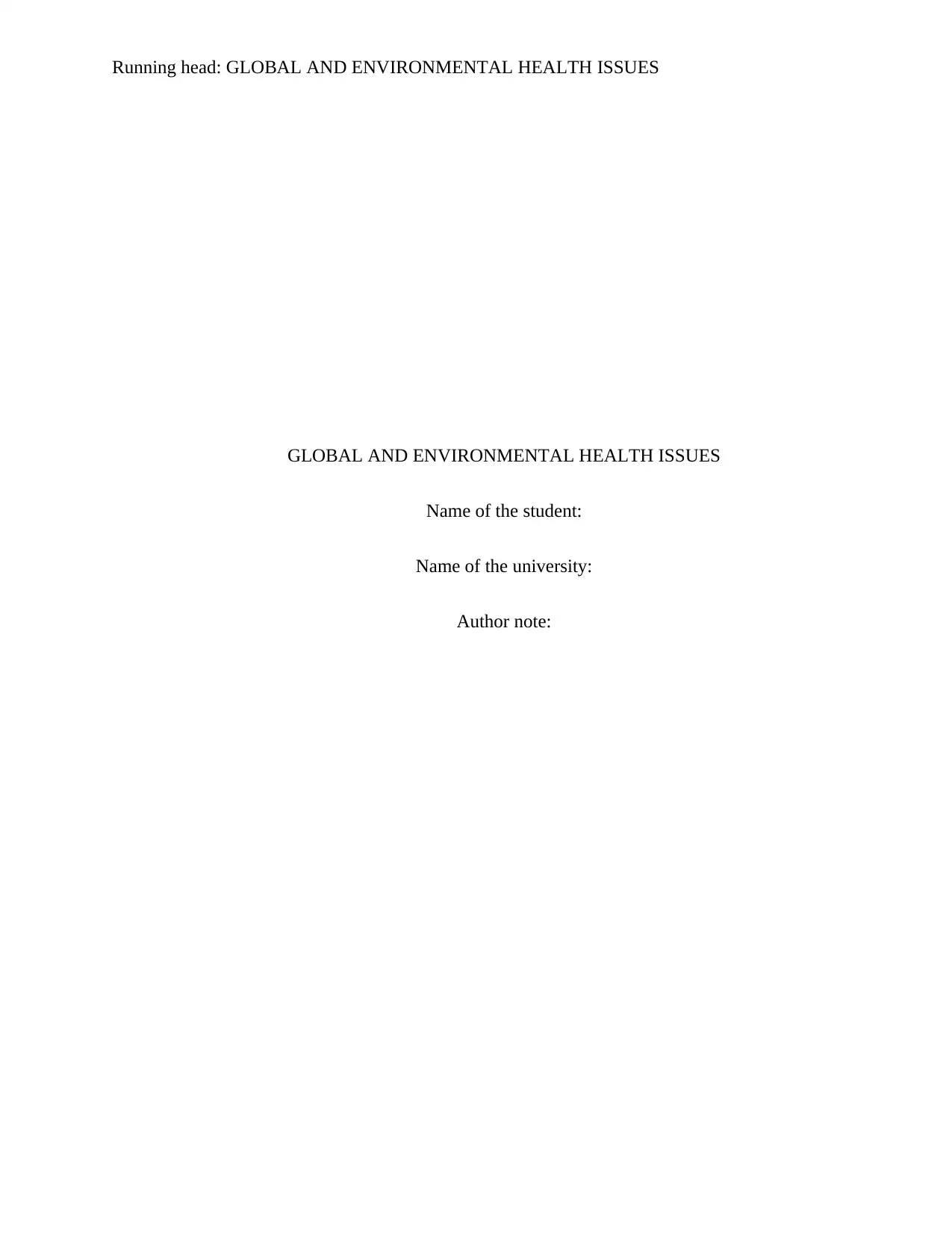
Running head: GLOBAL AND ENVIRONMENTAL HEALTH ISSUES
GLOBAL AND ENVIRONMENTAL HEALTH ISSUES
Name of the student:
Name of the university:
Author note:
GLOBAL AND ENVIRONMENTAL HEALTH ISSUES
Name of the student:
Name of the university:
Author note:
Paraphrase This Document
Need a fresh take? Get an instant paraphrase of this document with our AI Paraphraser
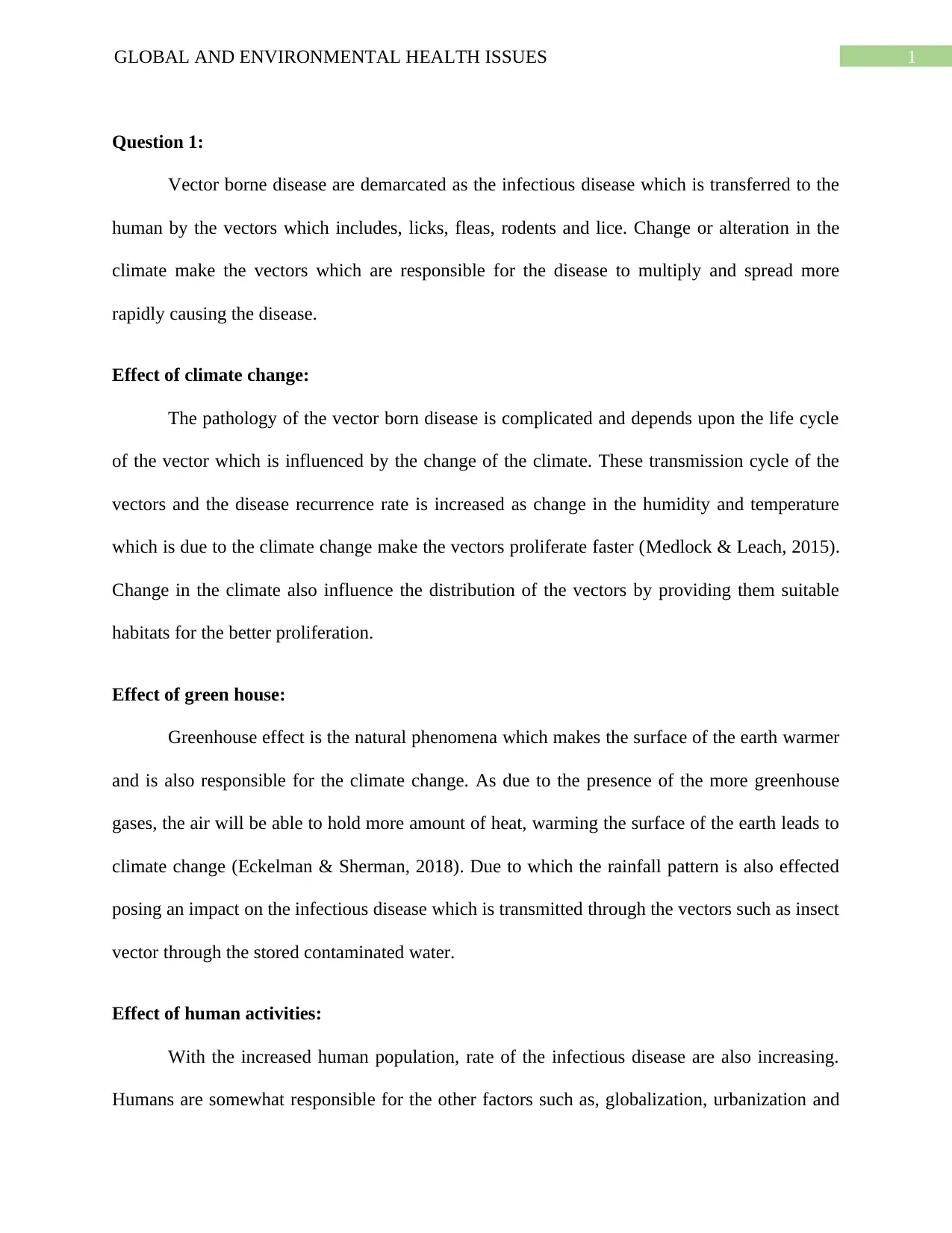
1GLOBAL AND ENVIRONMENTAL HEALTH ISSUES
Question 1:
Vector borne disease are demarcated as the infectious disease which is transferred to the
human by the vectors which includes, licks, fleas, rodents and lice. Change or alteration in the
climate make the vectors which are responsible for the disease to multiply and spread more
rapidly causing the disease.
Effect of climate change:
The pathology of the vector born disease is complicated and depends upon the life cycle
of the vector which is influenced by the change of the climate. These transmission cycle of the
vectors and the disease recurrence rate is increased as change in the humidity and temperature
which is due to the climate change make the vectors proliferate faster (Medlock & Leach, 2015).
Change in the climate also influence the distribution of the vectors by providing them suitable
habitats for the better proliferation.
Effect of green house:
Greenhouse effect is the natural phenomena which makes the surface of the earth warmer
and is also responsible for the climate change. As due to the presence of the more greenhouse
gases, the air will be able to hold more amount of heat, warming the surface of the earth leads to
climate change (Eckelman & Sherman, 2018). Due to which the rainfall pattern is also effected
posing an impact on the infectious disease which is transmitted through the vectors such as insect
vector through the stored contaminated water.
Effect of human activities:
With the increased human population, rate of the infectious disease are also increasing.
Humans are somewhat responsible for the other factors such as, globalization, urbanization and
Question 1:
Vector borne disease are demarcated as the infectious disease which is transferred to the
human by the vectors which includes, licks, fleas, rodents and lice. Change or alteration in the
climate make the vectors which are responsible for the disease to multiply and spread more
rapidly causing the disease.
Effect of climate change:
The pathology of the vector born disease is complicated and depends upon the life cycle
of the vector which is influenced by the change of the climate. These transmission cycle of the
vectors and the disease recurrence rate is increased as change in the humidity and temperature
which is due to the climate change make the vectors proliferate faster (Medlock & Leach, 2015).
Change in the climate also influence the distribution of the vectors by providing them suitable
habitats for the better proliferation.
Effect of green house:
Greenhouse effect is the natural phenomena which makes the surface of the earth warmer
and is also responsible for the climate change. As due to the presence of the more greenhouse
gases, the air will be able to hold more amount of heat, warming the surface of the earth leads to
climate change (Eckelman & Sherman, 2018). Due to which the rainfall pattern is also effected
posing an impact on the infectious disease which is transmitted through the vectors such as insect
vector through the stored contaminated water.
Effect of human activities:
With the increased human population, rate of the infectious disease are also increasing.
Humans are somewhat responsible for the other factors such as, globalization, urbanization and
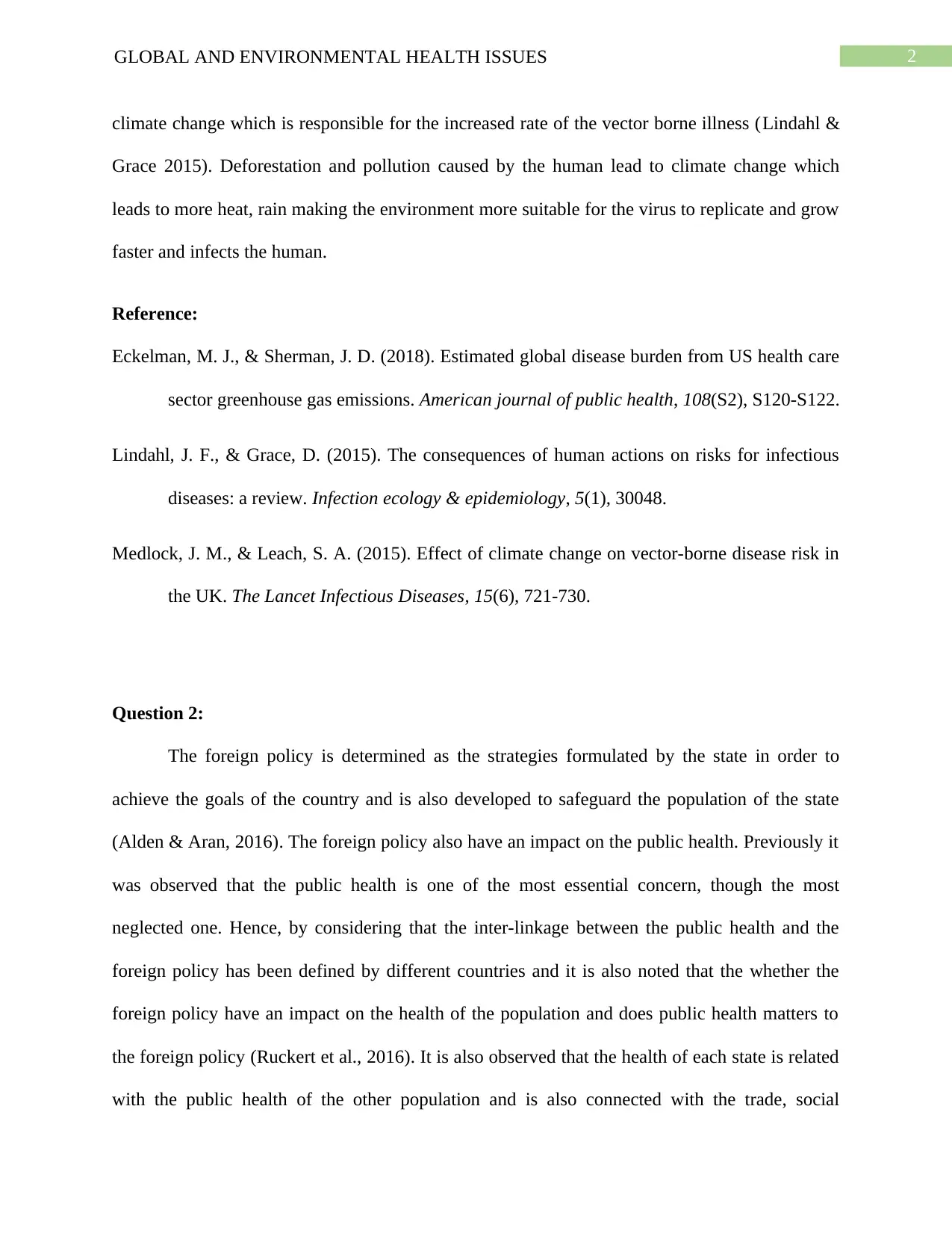
2GLOBAL AND ENVIRONMENTAL HEALTH ISSUES
climate change which is responsible for the increased rate of the vector borne illness (Lindahl &
Grace 2015). Deforestation and pollution caused by the human lead to climate change which
leads to more heat, rain making the environment more suitable for the virus to replicate and grow
faster and infects the human.
Reference:
Eckelman, M. J., & Sherman, J. D. (2018). Estimated global disease burden from US health care
sector greenhouse gas emissions. American journal of public health, 108(S2), S120-S122.
Lindahl, J. F., & Grace, D. (2015). The consequences of human actions on risks for infectious
diseases: a review. Infection ecology & epidemiology, 5(1), 30048.
Medlock, J. M., & Leach, S. A. (2015). Effect of climate change on vector-borne disease risk in
the UK. The Lancet Infectious Diseases, 15(6), 721-730.
Question 2:
The foreign policy is determined as the strategies formulated by the state in order to
achieve the goals of the country and is also developed to safeguard the population of the state
(Alden & Aran, 2016). The foreign policy also have an impact on the public health. Previously it
was observed that the public health is one of the most essential concern, though the most
neglected one. Hence, by considering that the inter-linkage between the public health and the
foreign policy has been defined by different countries and it is also noted that the whether the
foreign policy have an impact on the health of the population and does public health matters to
the foreign policy (Ruckert et al., 2016). It is also observed that the health of each state is related
with the public health of the other population and is also connected with the trade, social
climate change which is responsible for the increased rate of the vector borne illness (Lindahl &
Grace 2015). Deforestation and pollution caused by the human lead to climate change which
leads to more heat, rain making the environment more suitable for the virus to replicate and grow
faster and infects the human.
Reference:
Eckelman, M. J., & Sherman, J. D. (2018). Estimated global disease burden from US health care
sector greenhouse gas emissions. American journal of public health, 108(S2), S120-S122.
Lindahl, J. F., & Grace, D. (2015). The consequences of human actions on risks for infectious
diseases: a review. Infection ecology & epidemiology, 5(1), 30048.
Medlock, J. M., & Leach, S. A. (2015). Effect of climate change on vector-borne disease risk in
the UK. The Lancet Infectious Diseases, 15(6), 721-730.
Question 2:
The foreign policy is determined as the strategies formulated by the state in order to
achieve the goals of the country and is also developed to safeguard the population of the state
(Alden & Aran, 2016). The foreign policy also have an impact on the public health. Previously it
was observed that the public health is one of the most essential concern, though the most
neglected one. Hence, by considering that the inter-linkage between the public health and the
foreign policy has been defined by different countries and it is also noted that the whether the
foreign policy have an impact on the health of the population and does public health matters to
the foreign policy (Ruckert et al., 2016). It is also observed that the health of each state is related
with the public health of the other population and is also connected with the trade, social
⊘ This is a preview!⊘
Do you want full access?
Subscribe today to unlock all pages.

Trusted by 1+ million students worldwide
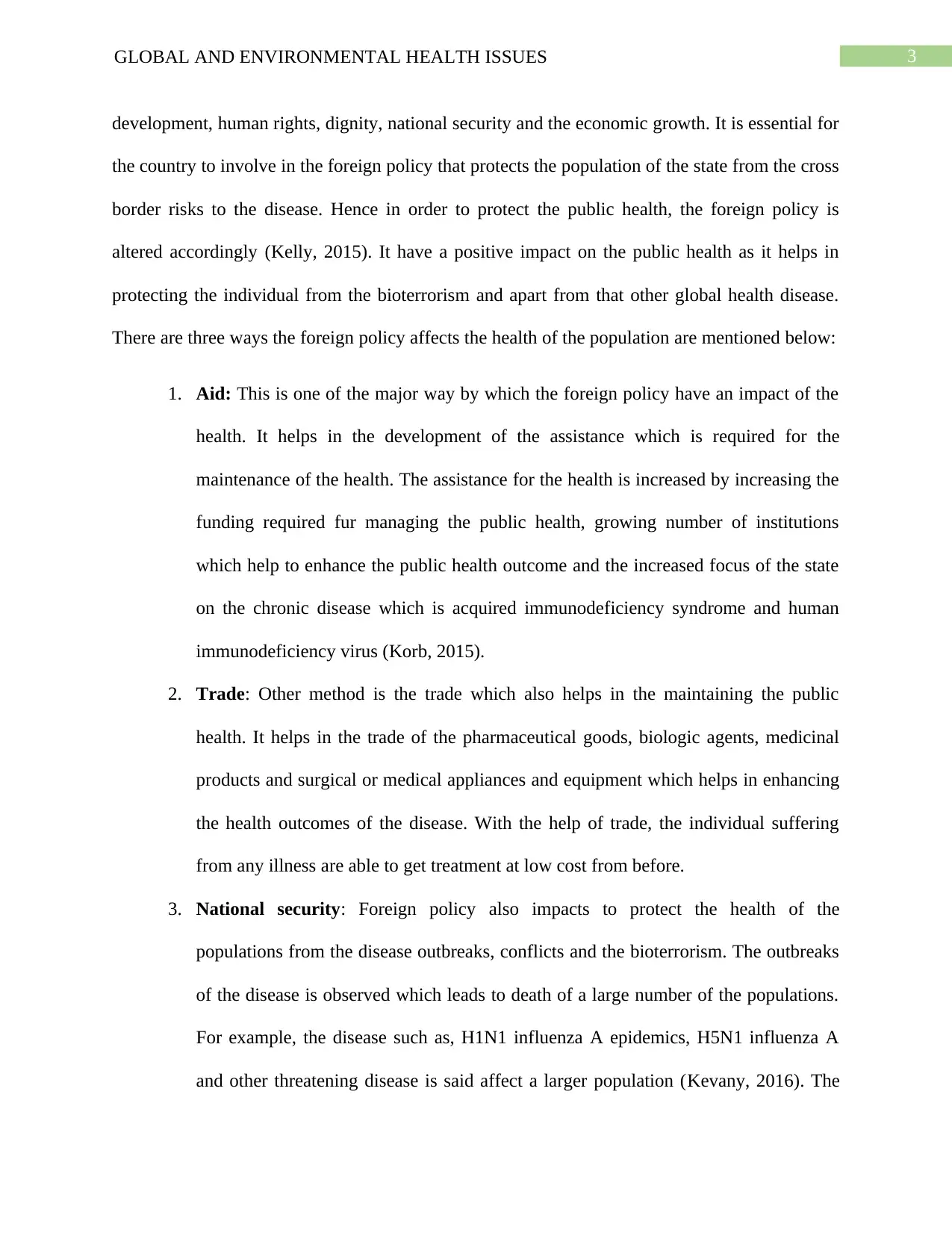
3GLOBAL AND ENVIRONMENTAL HEALTH ISSUES
development, human rights, dignity, national security and the economic growth. It is essential for
the country to involve in the foreign policy that protects the population of the state from the cross
border risks to the disease. Hence in order to protect the public health, the foreign policy is
altered accordingly (Kelly, 2015). It have a positive impact on the public health as it helps in
protecting the individual from the bioterrorism and apart from that other global health disease.
There are three ways the foreign policy affects the health of the population are mentioned below:
1. Aid: This is one of the major way by which the foreign policy have an impact of the
health. It helps in the development of the assistance which is required for the
maintenance of the health. The assistance for the health is increased by increasing the
funding required fur managing the public health, growing number of institutions
which help to enhance the public health outcome and the increased focus of the state
on the chronic disease which is acquired immunodeficiency syndrome and human
immunodeficiency virus (Korb, 2015).
2. Trade: Other method is the trade which also helps in the maintaining the public
health. It helps in the trade of the pharmaceutical goods, biologic agents, medicinal
products and surgical or medical appliances and equipment which helps in enhancing
the health outcomes of the disease. With the help of trade, the individual suffering
from any illness are able to get treatment at low cost from before.
3. National security: Foreign policy also impacts to protect the health of the
populations from the disease outbreaks, conflicts and the bioterrorism. The outbreaks
of the disease is observed which leads to death of a large number of the populations.
For example, the disease such as, H1N1 influenza A epidemics, H5N1 influenza A
and other threatening disease is said affect a larger population (Kevany, 2016). The
development, human rights, dignity, national security and the economic growth. It is essential for
the country to involve in the foreign policy that protects the population of the state from the cross
border risks to the disease. Hence in order to protect the public health, the foreign policy is
altered accordingly (Kelly, 2015). It have a positive impact on the public health as it helps in
protecting the individual from the bioterrorism and apart from that other global health disease.
There are three ways the foreign policy affects the health of the population are mentioned below:
1. Aid: This is one of the major way by which the foreign policy have an impact of the
health. It helps in the development of the assistance which is required for the
maintenance of the health. The assistance for the health is increased by increasing the
funding required fur managing the public health, growing number of institutions
which help to enhance the public health outcome and the increased focus of the state
on the chronic disease which is acquired immunodeficiency syndrome and human
immunodeficiency virus (Korb, 2015).
2. Trade: Other method is the trade which also helps in the maintaining the public
health. It helps in the trade of the pharmaceutical goods, biologic agents, medicinal
products and surgical or medical appliances and equipment which helps in enhancing
the health outcomes of the disease. With the help of trade, the individual suffering
from any illness are able to get treatment at low cost from before.
3. National security: Foreign policy also impacts to protect the health of the
populations from the disease outbreaks, conflicts and the bioterrorism. The outbreaks
of the disease is observed which leads to death of a large number of the populations.
For example, the disease such as, H1N1 influenza A epidemics, H5N1 influenza A
and other threatening disease is said affect a larger population (Kevany, 2016). The
Paraphrase This Document
Need a fresh take? Get an instant paraphrase of this document with our AI Paraphraser
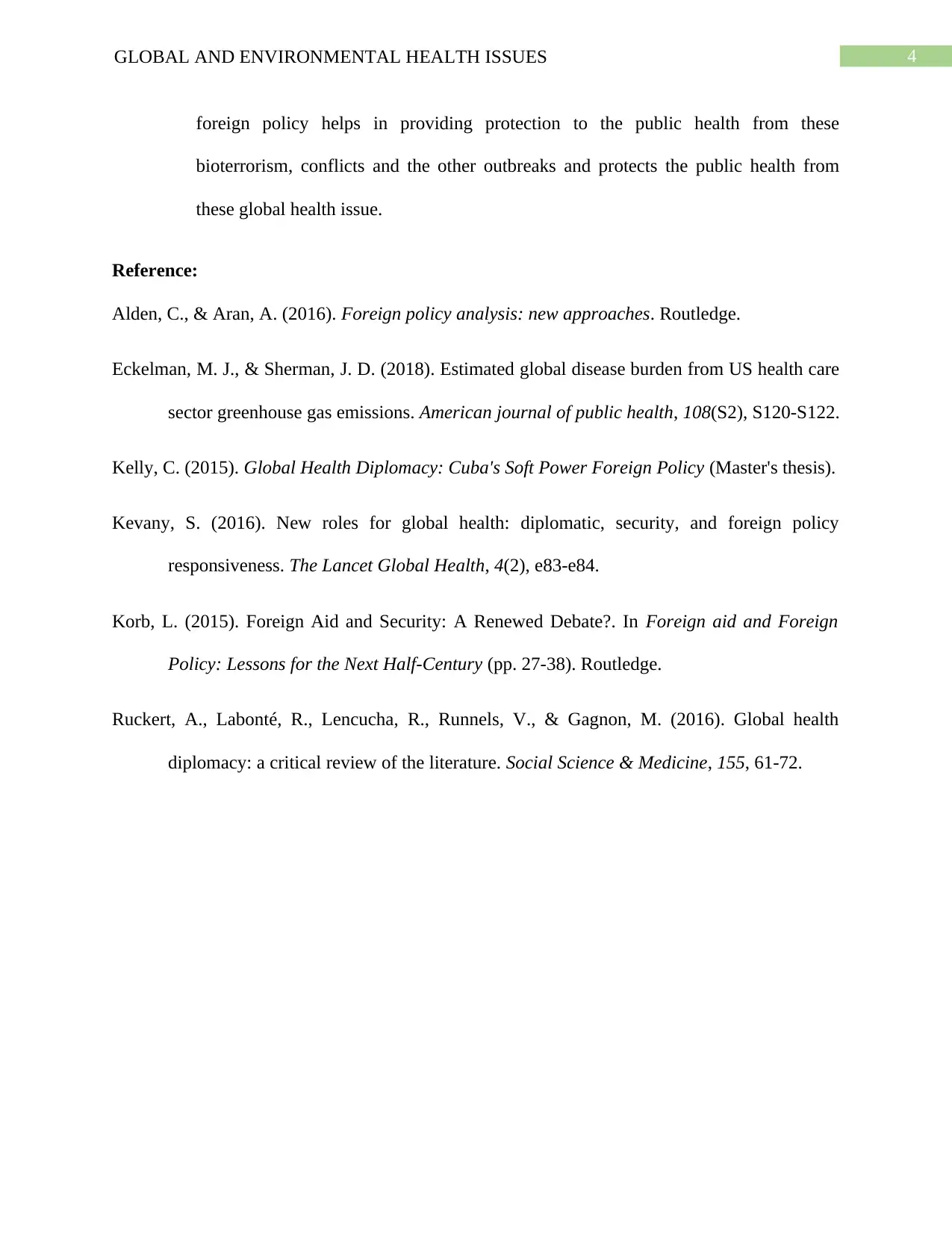
4GLOBAL AND ENVIRONMENTAL HEALTH ISSUES
foreign policy helps in providing protection to the public health from these
bioterrorism, conflicts and the other outbreaks and protects the public health from
these global health issue.
Reference:
Alden, C., & Aran, A. (2016). Foreign policy analysis: new approaches. Routledge.
Eckelman, M. J., & Sherman, J. D. (2018). Estimated global disease burden from US health care
sector greenhouse gas emissions. American journal of public health, 108(S2), S120-S122.
Kelly, C. (2015). Global Health Diplomacy: Cuba's Soft Power Foreign Policy (Master's thesis).
Kevany, S. (2016). New roles for global health: diplomatic, security, and foreign policy
responsiveness. The Lancet Global Health, 4(2), e83-e84.
Korb, L. (2015). Foreign Aid and Security: A Renewed Debate?. In Foreign aid and Foreign
Policy: Lessons for the Next Half-Century (pp. 27-38). Routledge.
Ruckert, A., Labonté, R., Lencucha, R., Runnels, V., & Gagnon, M. (2016). Global health
diplomacy: a critical review of the literature. Social Science & Medicine, 155, 61-72.
foreign policy helps in providing protection to the public health from these
bioterrorism, conflicts and the other outbreaks and protects the public health from
these global health issue.
Reference:
Alden, C., & Aran, A. (2016). Foreign policy analysis: new approaches. Routledge.
Eckelman, M. J., & Sherman, J. D. (2018). Estimated global disease burden from US health care
sector greenhouse gas emissions. American journal of public health, 108(S2), S120-S122.
Kelly, C. (2015). Global Health Diplomacy: Cuba's Soft Power Foreign Policy (Master's thesis).
Kevany, S. (2016). New roles for global health: diplomatic, security, and foreign policy
responsiveness. The Lancet Global Health, 4(2), e83-e84.
Korb, L. (2015). Foreign Aid and Security: A Renewed Debate?. In Foreign aid and Foreign
Policy: Lessons for the Next Half-Century (pp. 27-38). Routledge.
Ruckert, A., Labonté, R., Lencucha, R., Runnels, V., & Gagnon, M. (2016). Global health
diplomacy: a critical review of the literature. Social Science & Medicine, 155, 61-72.
1 out of 5
Related Documents
Your All-in-One AI-Powered Toolkit for Academic Success.
+13062052269
info@desklib.com
Available 24*7 on WhatsApp / Email
![[object Object]](/_next/static/media/star-bottom.7253800d.svg)
Unlock your academic potential
Copyright © 2020–2025 A2Z Services. All Rights Reserved. Developed and managed by ZUCOL.





